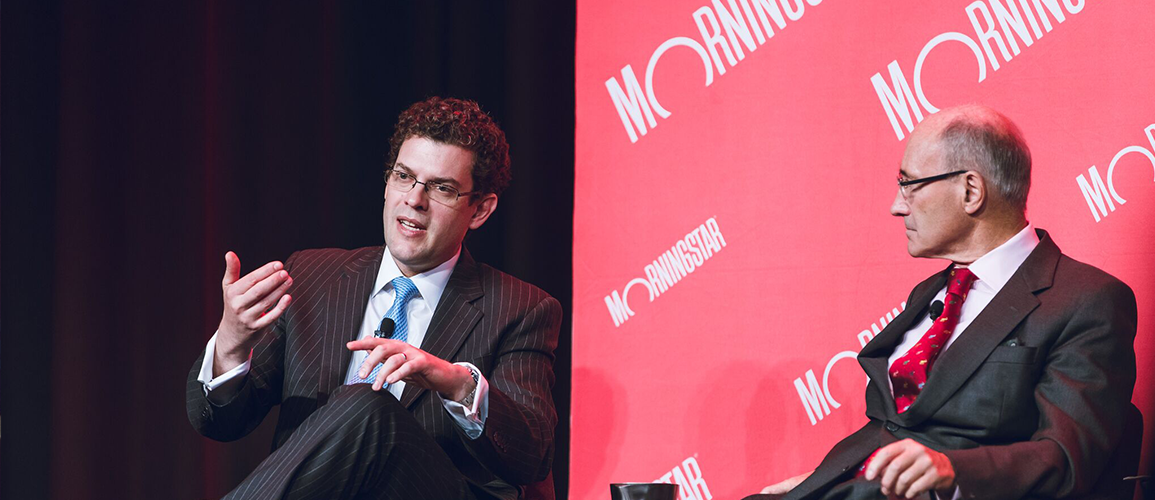The curtain was raised at the 2018 Morningstar Investment Conference with presentations from two investing heavyweights. In the fixed-income corner was Dr Michael Hasenstab, executive vice president, portfolio manager, and chief investment officer for Templeton Global Macro (Franklin Templeton Multisector Bond W 17390). In the equity corner was, Kerr Neilson, founder and portfolio manager at Platinum Asset Management (Platinum International Fund 4505).
Crossfire Hurricanes
Michael Hasenstab started his presentation with a warning about complacency in the U.S. Treasury market and a forecast of “four hurricanes” approaching:
Hurricane 1 — Monetary Tightening. The Federal Reserve is no longer going to finance the U.S. deficit, so other participants will need to pick up the slack. Hasenstab believes without the Federal Reserve, the Chinese, or cashed-up OPEC nations looking to invest their petro-dollars, the purchasing burden will fall on domestic investors. To bridge the gap this group will need to triple its purchases of U.S government debt and will need significantly higher rates (as much as 5% was mentioned) to entice them to do so.
Hurricane 2 — A swelling U.S. fiscal deficit. By Franklin Templeton’s estimates the U.S. budget deficit will exceed 5% of gross domestic product in 2019 and could go as high as 8%.
Hurricane 3 — Inflation. U.S. banks are starting to extend more credit as regulation loosens. This will result in the velocity of money increasing, and ultimately inflation will be unleashed. At the same time the labour market will get tighter with more stringent immigration laws. Finally, as relations with China become more antagonistic, cheap imports from China could become a thing of the past.
Hurricane 4 — Economic Growth. Hasentab argued that the tax cuts are “unambiguously stimulative” and 3% GDP growth this year wouldn’t surprise him.
The bond manager concluded that this “perfect storm” means higher inflation and higher interest rates. Consequently, he has a large short U.S. Treasury position across the strategies he manages.
The pessimistic predictions continued. He believes there are deep fault lines appearing in the European monetary union. Many European citizens have become increasingly concerned with immigration and terrorism. Consequently, populist parties are attracting votes, with many Euro-skeptic parties taking share across the continent. Hasenstab and his colleagues believe this lack of political cohesion means bailing out heavily indebted Italy or Greece are no longer viable options.
Hasenstab’s presentation concluded with a fascinating insight into how the global macro team use environmental, social, and governance (ESG) factors to rank sovereigns. Rather than follow a basic process which excludes countries using backward-looking information, Franklin Templeton has created a process where they invest into nations that are showing signs of improvement. They believe emerging economies like Brazil, Argentina, and India are on an upward trajectory and invest appropriately, while, Poland, the U.S., and Italy are in decline and not in Hasenstab’s portfolios.
Facts and Feelings
Kerr Neilson followed with a presentation on fact versus feelings. He started by comparing investor’s feelings about certain assets to the facts, using a timely example of a typical property investment. If an investor purchased a property for $500,000 in 2000 and sold it in 2016 for $2,000,000 they realised a fourfold increase. But in reality, the compound return over the holding period is around 8%, and after accounting for the various costs levied, the return is quite modest. Local investors have a similar love affair with domestic equities. Neilson again proposed that this was more feeling than fact, as the data proves Australian fixed-income and global shares have outpaced the ASX 200 over the past 10 years.
Neilson, ever the contrarian, also showed that war can be positive…for the equity markets of the victor. The U.S. and U.K. stock markets rose by 22% and 34%, respectively, during the Second World War, while the Japanese and German markets fell 96% and 88%, respectively.
Another interesting section of Neilson’s presentation was how corporate profitability has been significantly higher over the past 50 years compared with the previous 80. He suggested the change was due, in part, to the rampant advance in technology—a trend, he believes, that is unlikely to continue. In contrast, the profit share as a percentage of GDP for the emerging markets is set to rebound.
The next topic was resources. Neilson suggested copper is a good way to benefit from the continued urbanisation of the developing world, highlighting that copper consumption increases alongside the urbanisation rate. In fact, this trend will support demand for a range of commodities, including other bulk metals and oil. He also pointed out that increasing demand for electric vehicles would boost copper prices. But, electric vehicles would, in the long run, keep demand for liquid fuel in cars flat.
Q&A
In the subsequent discussion, both Hasenstab and Neilson warned of the risks of investing in passive strategies. Liquidity was a top concern on the bond side. Hasenstab cautioned that passive outflows could create liquidity issues, exacerbated by investment banks no longer providing a market-making function. While both were concerned about passive investing, they believe it creates pockets of opportunities in their respective opportunity sets. This enthralling session from two of the industry’s deepest thinkers gave delegates much to ponder and set the scene perfectly for the rest of the conference.
 Morningstar
Morningstar





